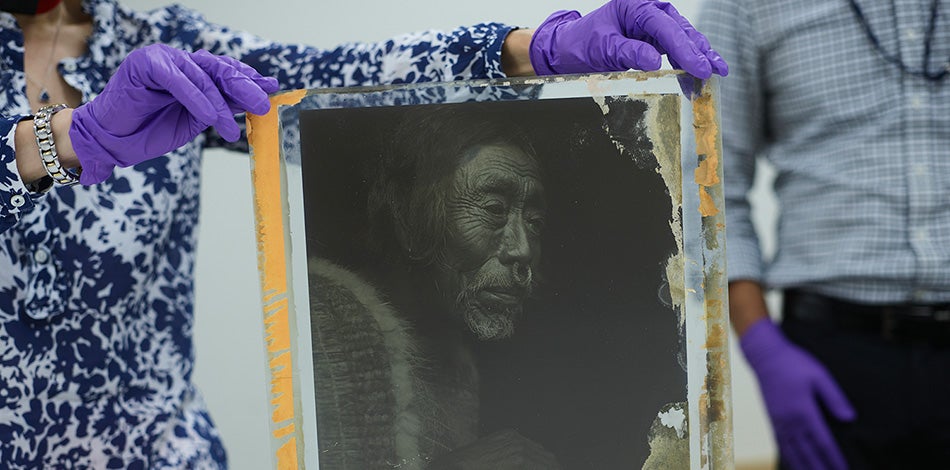University of Pennsylvania Libraries Receives Major Gift of Photographic Plates by Edward S. Curtis

The University of Pennsylvania Libraries has received a rare collection of 151 interpositive glass plates by photographer Edward S. Curtis (1868–1952) from collector William H. Miller III. Appraised at $4.2 million, the gift to the Penn Libraries complements holdings across the University, making Penn a major center for research and work on Curtis, one of the most prolific American photographers of the late 19th and early 20th centuries.
Curtis photographed Native Americans from more than 80 tribes over three decades. Selecting from among the 40,000 photographs he took, he produced a 20-volume work titled “The North American Indian,” published between 1907 and 1930.
“The Penn Libraries has made it a strategic priority to build, preserve, and steward collections with a focus on education, access, and resource-sharing,” said Constantia Constantinou, H. Carton Rogers III Vice Provost and Director of Libraries. “It is an honor to receive this gift, which significantly expands our collections in the history of photography.”
Curtis used a photogravure process in which interpositive glass plates represent a key moment between capture and a final printed image. Every 14 x 17 glass negative that Curtis prepared was printed again as a glass positive before the image was moved onto a copperplate for etching. The vast majority of the interpositive glass plates Curtis produced were destroyed. The collection of 151 plates received by the Penn Libraries is the largest group known to have survived and contains detail lost in the printing process.
Miller made the gift to the Penn Libraries based on guidance from Stephan Loewenthiel, founder and president of the 19th Century Rare Book and Photograph Shop and a member of the Penn Libraries Board of Advisors.
"The use of glass plates by the great 19th century photographers, including Edward Curtis, required a cumbersome and time-consuming process involving heavy equipment, delicate glass plates, volatile chemicals and great artistic ability to make each photograph successful,” said Loewenthiel. “The Penn Libraries, in conjunction with the Penn Museum, will allow this process and resulting masterworks to be exhibited and studied, allowing for both wide public exposure and study by experts, students and the interested public."
Scholars have noted that Curtis removed aspects of modernity, such as alarm clocks, from the final prints he made, and that many of his images are highly stylized. Curtis often posed the people he photographed for his “North American Indian” volumes dressed in traditional clothing.
“Edward S. Curtis’s photographs raise complex issues of representation of Native American peoples in both the past and the present” said Christopher Woods, Williams Director of the Penn Museum. “This gift to the Penn Libraries complements the Penn Museum’s existing Curtis collection. Through interdisciplinary collaboration at the University and beyond, we can create meaningful opportunities to expand teaching and research in conversation with today’s living Native American photographers, scholars, artists, students, and community members.”
The Penn Museum’s link to Curtis dates back to 1912, when he first exhibited his photographs there. The Museum Archives includes among its holdings 66 platinum prints signed by Curtis and 109 photogravures. The Museum Library has a nearly complete set of the original edition of “The North American Indian;” it is missing volumes one and four, among its 20 volumes of text, and portfolio 12 among the accompanying 20 volumes of portfolio plates.
The collection of interpositive glass plates from Miller also complements growing photographic collections held by the Penn Libraries’ Kislak Center for Special Collections, Rare Books, and Manuscripts, which include recent gifts by Arthur Tress and Laurence Salzmann. The Curtis plates will join foundational collections in the history of photography, such as the Eadweard Muybridge Collection, and collections focused on Native American cultures and histories, such as the Berendt-Brinton Linguistic Collection and the Brinton Library; the Robert Dechert Collection; and the Caroline Schimmel Collection. Related materials across the University include Muybridge collections at the University of Pennsylvania Archives, two Curtis photographs in the Penn Art Collection, and other collections of Curtis materials at the Penn Museum Archives.
Curators in the Penn Libraries and in the Penn Museum will work together to study, interpret, and introduce audiences to these works, and to understand their significance alongside other objects, artifacts, images, and books.
“Teaching with collections and making them accessible to researchers is central to our work,” said Sean Quimby, Associate University Librarian and Director of the Kislak Center. “The staff of the Kislak Center are developing a plan to catalog, preserve, and provide access to the glass plates in the classroom, exhibition galleries, and online. We look forward to partnering with colleagues at Penn to steward this collection.”
ABOUT THE KISLAK CENTER
The Kislak Center for Special Collections, Rare Books and Manuscripts advances learning and inspires discovery in Penn's community and around the world. The goals of the Kislak Center align with those of the Penn Libraries as a whole: to make our collections accessible; to use technology in innovative and meaningful ways; to enhance teaching and research; and to preserve our cultural resources for future generations.
ABOUT THE PENN LIBRARIES
The Penn Libraries provides a network of information resources and knowledge services that are vital to teaching, research, and learning at the University of Pennsylvania. This network includes 14 physical libraries, recognized for their collections, and a digital library known for innovation and richness of content. Through exhibitions and lectures, and through the acquisition and preservation of literary and artistic artifacts, the Penn Libraries documents a wealth of social and historical periods, bringing scholarship to life at the University and in the various communities it serves.
Find a selection of downloadable images approved for publication on Box.
For press inquiries, please contact Monica Fonorow, Communications Coordinator for the Penn Libraries.
Date
October 20, 2021
